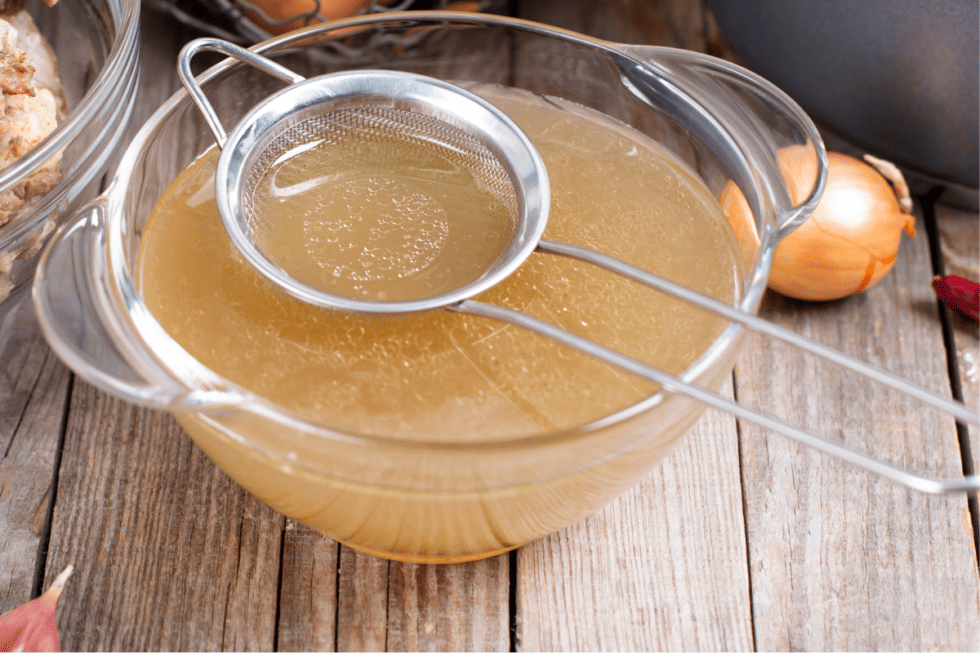
Meat Broth Recipe: Low Histamine Bone Broth Alternative (Low Oxalate, Low Lectin, Low FODMAP, Low Salicylate)
High histamine bone broth is one of those “healthy” foods you may have to let go when you have Histamine Intolerance or Mast Cell Activation Syndrome (MCAS). But have you tried meat broth?
Bone broth in a crockpot has become a major health fad over the past few years. And a lot of people have done well with it.
So, what is it about bone broth? Why is it thought to be healthy?
And if it is healthy, why does it cause problems for Mast Cell Activation Syndrome or Histamine Intolerance?
Learn what makes bone broth high histamine and what you can make instead!
My delicious meat broth alternative is:
- Low histamine
- Low oxalate to medium oxalate
- Low lectin
- Low salicylate
- Low FODMAP
- Gluten free
- Dairy free
Plus, you don’t need any special tools like a pressure cooker. It’s simple to make on your stove top.
Before you change your diet on your own, please make sure you’re working with a healthcare practitioner who can help you with this. Never limit foods unnecessarily, and always have a licensed medical provider who is supervising your case.
My Broth Journey
I’ve made bone broth so many times over my life.
I worked so hard to recover my health. And I tried anything I could get my hands on! Bone broth was one of the early things I came across almost 20 years ago.
I first got into making a bone broth recipe when I was following the Weston A. Price Foundation. And their way of cooking traditional foods like marrow bones.
I’d make homemade broth with all kinds of animal bones like beef bones. I even simmered chicken broth with feet! This was to get the maximum gelatin and collagen content for gut healing.
I read how good drinking bone broth was supposed to be for healing the gut. And also for joint health.
Back then, I was dealing with all kinds of gut symptoms. But I was also struggling with pain in my joints. And difficulty walking.
I had fatigue, severe allergy issues, and anxiety. And at that point, no one really had any clue of what was happening with me – and I certainly didn’t.
So, making bone broth in a large stock pot was one of my early forays into healthier eating.
I had cleaned up the processed foods in my diet. And I’d taken out most of the sugar. And then I was also working on learning which foods were the most nutrient dense.
Now, when I take something on, I take it on fully. So, I became a bit of a master when it comes to making bone broth.
I was also making ferments, my own kefir, and my own sourdough bread. (A lot of high histamine foods!)
Is Bone Broth High Histamine?
Yes, bone broth is high histamine.
The problem was that I didn’t know that I had both Mast Cell Activation Syndrome and Histamine Intolerance. And these foods were a nightmare for mast cells and my histamine levels.
Eventually, I realized that the bone broth was actually triggering a lot of my symptoms. And it made me so sad to give it up and let it go!
When I figured this out, I had to start going against what I thought was correct about health.
I was doing quite a lot of cooking from that Weston A. Price perspective. And it’s a really great way of eating for a lot of people.
I loved the philosophy of Weston A. Price.
And I loved the focus on going back to our more traditional ways of eating. And for restoring our health.
I thought these would be the magic bullet for my health concerns.
Eventually, I had to learn other ways to improve my gut health.
I had to start opening my mind to what was right for my personal health and my unique situation.
Bone broth does have some health benefits. Let’s look at some of those, next.
Bone Broth Benefits
Bone broth can certainly be food that can help many people’s gut and joints. (Unless you have Mast Cell Activation Syndrome, Histamine Intolerance, or Oxalate Issues like me.)
There isn’t a lot of solid scientific data on bone broth.
But bone broth has many reported benefits like:
- Providing an easy to digest source of key vitamins and minerals
- Supporting the gut with amino acids like glycine and arginine
- Soothing the gut lining and promoting healing
- Improving joint health with collagen
- Promoting restful sleep due to its glycine content
- Plus it’s a high protein source
Bone broth is believed to help lower inflammation. And also provide amino acids needed by the gut lining.
This is why it’s often recommended in gut health protocols for things like Leaky Gut.
Many people who are dealing with conditions such as Inflammatory Bowel Disease (IBD) use bone broth to help their guts. This includes Crohn’s Disease & Ulcerative Colitis.
It’s also recommended for Irritable Bowel Syndrome (IBS) and Small Intestine Bacterial Overgrowth (SIBO).
But it can be a problem for those with MCAS or Histamine Intolerance! Let’s look at why.
Problems with Bone Broth for Mast Cells and Histamine Levels
The main reason why bone broth causes problems for those of us with Mast Cell Activation Syndrome (MCAS) or Histamine Intolerance is the histamine!
Meat or bones that are cooked for a long time release a fair amount of histamine into the broth.
The apple cider vinegar that many recipes add is also high histamine.
And that’s the very thing we’re trying to avoid. Unfortunately, it’s still high histamine even if you cook it in the Instant Pot instead of a slow cooker.
This build up of histamine is what can lead to dreaded symptoms like:
- Bloating
- Brain fog
- Hives
- Rashes
- And more
Can you relate to any of these histamine reactions?
Histamine is one potential trigger! And it’s an important one. But there are others, too.
Let’s look next at some of the other potential triggers in bone broth.
Other Mast Cell Triggers in Bone Broth
Beyond the histamine issues, there are other problems. So, you can’t just take extra diamine oxidase (DAO) enzyme with bone broth.
Bone broth is rich in the amino acid glycine. And unfortunately, glycine can be converted to oxalates and glutamate in the body.
This is because pressure cooking can lower lectins in foods. And it can certainly reduce the cooking time.
However, it’s not going to remove the oxalates or glutamates.
Read More: What Are Oxalates?
Wondering how you’ll ever be able to make delicious soup again?
Don’t worry! In the next section, I’ll give you an easy and tasty alternative!
Here’s what to do instead.
What Is Meat Broth?
Meat broth is the best gut supporting bone broth alternative for people with Mast Cell Activation Syndrome or Histamine Intolerance.
Since there really isn’t a low histamine bone broth, what can we make instead? Meat broth!
Meat broth is a wonderful alternative to slow cooked, histamine rich bone broth.
Meat broth is made with just the meat (not the bones) and vegetables. It’s simmered for a short time. So, the histamine release is minimal.
Are there still benefits, despite the shortened cooking time? Absolutely.
That’s great news for anyone on the low histamine diet.
Here are some benefits of meat broth:
- Still has the healing amino acids
- Supports the gut
- Soothes the digestive system
- Much lower in histamine
- Much lower in glycine (fewer oxalate or glutamate issues)
- Easy to make
- Can drink it on its own or use it in low histamine recipes like these:
- Can freeze in cubes for future meals

To make sure you’re getting the benefits without the drawbacks of bone broth, there are a few things to keep in mind.
Next, I’ll share a few cooking tips for keeping your meat broth low histamine.
Meat Broth Recipe Tips
There are some tips I want to share with you before you get started on this meat broth recipe.
Read these to make sure you get the most out of this new technique for low histamine broth.
Low Histamine Meat Broth Sources
Use low histamine meat without mast cell triggers.
If you’re going to make fish broth, make sure it’s wild caught and flash frozen right after it’s caught.
Vital Choice has a lower histamine option. I recommend starting with their king salmon.

>>> Take a look at Vital Choice here!
You’ll want to buy pasture raised meats that are fed organic non GMO grains.
Buy meat as fresh as possible. It should be frozen right after slaughter. Your best bet is your local farmer.
If you don’t have a local farmer, here are your best 2 options:
White Oak Pastures carries chicken, turkey, lamb, and other meats you can use to make this meat broth recipe.
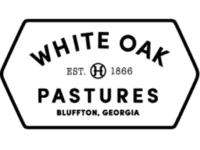
>>> For 10% off use coupon code MASTCELL360 on your first purchase of White Oak Pastures!
Most beef is aged making it higher histamine. If you want to make beef broth, make sure you are using a non aged beef.
NorthStar Bison has some options for non aged beef.
They also have pastured chicken, turkey, and rabbit that are frozen right after slaughter. Sometimes they have low histamine fish in stock but it’s not always available.

>>> Use coupon code MASTCELL360 for 10% all low histamine meats!
Low Histamine Meat Broth Prep
Remember to thaw your meat in the fridge. Letting it thaw on the counter at room temperature will build more histamine.
Also, don’t let the meat sit in the fridge after it is thawed. It will build more histamine.
Learn More: Low Histamine Meat Handling Tips for Preparation, Cooking, and Storage
How to Store Meat Broth
You can make a big batch and freeze for other recipes. Or you can even just drink it to soothe your tummy.
To freeze for later, I really like these large 100% BPA free food grade silicone trays for freezing meat broth in. Each compartment is 1 cup. This is the perfect size for a recipe or for drinking.
They come with lids, so they’re easy to stack.

You can also easily double, triple, or quadruple this recipe to use it on days when you’re really fatigued.
Meat Broth Add Ins
I always use my favorite sea salt by Redmond Real Salt.
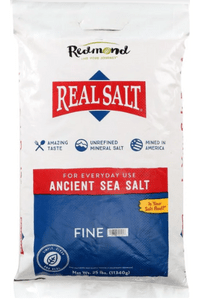
>>> Use coupon code MASTCELL360 to get 15% off!
Use whatever aromatics fit your food intolerances.
If you’d typically use black peppercorns in your broth, use pink peppercorns. Black pepper is high in histamine and high oxalates.
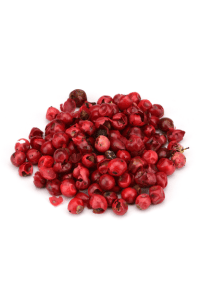
Use flat leaf parsley instead of curly parsley. Flat leaf parsley is lower in oxalates.
If you are avoiding salicylates, then stick with:
- Cilantro
- Parsley
- Onion
- And garlic
If you are avoiding fodmaps, substitute green onion tops for onions. And use garlic infused olive oil instead of cloves.

All right, now you’ve got some notes from the chef. Let’s get cooking!
Here’s the recipe for low histamine, delicious meat broth…
The great thing about this recipe is that it’s very versatile. You can add any combination of seasonings to adapt it for your soup recipe. Or even for your mood!
What are your favorite ingredients to make a meat broth recipe with?

Low Histamine Meat Broth Recipe
Equipment
- Sharp Knife
- Large Stock Pot with Lid
- Silicone Storage Cubes for leftovers
Ingredients
Meat Broth
- 2 cups Low Histamine Meat without bones, thawed
- 2 cups Filtered Water
- 2 stalks Celery sliced
- 1 Onion chopped
- 2 cloves Garlic minced
- 1 teaspoon Redmond Real Salt
Meat Broth Optional Seasonings
- 1 teaspoon Fresh Cilantro
- 1 teaspoon Fresh Ginger
- 1 teaspoon Lemongrass
- 1 teaspoon Flat Leaf Parsley
- 1 teaspoon Fresh Rosemary
- 1 teaspoon Fresh Thyme Leaves
- 1 teaspoon Fresh Oregano
- 1 teaspoon Fresh Basil Leaves
Instructions
- Boil your water in a pot over high heat.
- If desired, chop your vegetables.
- When it’s boiling, carefully add meat, vegetables, salt, and any seasonings you wish and let it come to a boil again.
- Simmer for 20 minutes over low heat.
- Take off heat and let cool for 5 minutes.
- Strain and enjoy as is.
- Freeze any leftovers immediately. Transfer to silicone cubes to freeze for future recipes.
Notes
Nutrition
Remember to make your meat broth with low histamine meats from these sources!
These are low histamine food options from brands we’ve tested and use regularly.
NorthStar Bison

>>> Use coupon code MASTCELL360 to get 10% off at NorthStar Bison meats!
White Oak Pastures

>>> Use coupon code MASTCELL360 for 10% off your first White Oak Pastures order!
Vital Choice

If you are very histamine intolerant, start with their lowest histamine option: King Salmon.
>>> Use this link to check out Vital Choice
More Low Histamine Drinks
- Pumpkin Spice Drink – Low Oxalate, Low Lectin, and Low FODMAP
- Tulsi Rose Tea – Low Oxalate, Low Lectin, and Low FODMAP
- Iced Hibiscus Tea – Low Oxalate and Low Lectin
- Elderflower Sparkling Wine Cocktail (plus Mocktail option) – Low Oxalate, Low Lectin, and Low FODMAP
Some links in this website are affiliate links, which means Mast Cell 360 may make a very small commission if you purchase through the link. It never costs you any more to purchase through the links, and we try to find the best deals we can. We only recommend products that we love and use personally or use in the Mast Cell 360 practice. Any commissions help support the newsletter, website, and ongoing research so Mast Cell 360 can continue to offer you free tips, recipes, and info. Thank you for your support!
References
Achamrah, N., Déchelotte, P., & Coëffier, M. (2017). Glutamine and the regulation of intestinal permeability: from bench to bedside. Current opinion in clinical nutrition and metabolic care, 20(1), 86–91. https://doi.org/10.1097/MCO.0000000000000339
Arora, B., Peacock, M., Robertson, W. G. (1989). Effect of glycine on urinary risk factors of kidney stone disease. Nutrition Research. 9(9), 1027-1031, ISSN 0271-5317. https://doi.org/10.1016/S0271-5317(89)80063-6
Clegg, M. E., Ranawana, V., Shafat, A., & Henry, C. J. (2013). Soups increase satiety through delayed gastric emptying yet increased glycaemic response. European journal of clinical nutrition, 67(1), 8–11.https://doi.org/10.1038/ejcn.2012.152
HappyForks. (n.d.). Recipe analyzer. https://happyforks.com/analyzer/result#
Henrotin, Y., Mobasheri, A., & Marty, M. (2012). Is there any scientific evidence for the use of glucosamine in the management of human osteoarthritis?. Arthritis research & therapy, 14(1), 201. https://doi.org/10.1186/ar3657
Hsu, D. J., Lee, C. W., Tsai, W. C., & Chien, Y. C. (2017). Essential and toxic metals in animal bone broths. Food & nutrition research, 61(1), 1347478. https://doi.org/10.1080/16546628.2017.1347478
Kawai, N., Sakai, N., Okuro, M., Karakawa, S., Tsuneyoshi, Y., Kawasaki, N., Takeda, T., Bannai, M., & Nishino, S. (2015). The sleep-promoting and hypothermic effects of glycine are mediated by NMDA receptors in the suprachiasmatic nucleus. Neuropsychopharmacology : official publication of the American College of Neuropsychopharmacology, 40(6), 1405–1416. https://doi.org/10.1038/npp.2014.326
Lan, Y., Zhu, W., Duan, X., Deng, T., Li, S., Liu, Y., Yang, Z., Wen, Y., Luo, L., Zhao, S., Wang, J., Zhao, Z., Wu, W., & Zeng, G. (2021). Glycine suppresses kidney calcium oxalate crystal depositions via regulating urinary excretions of oxalate and citrate. Journal of cellular physiology, 236(10), 6824–6835. https://doi.org/10.1002/jcp.30370
Leidy H. J. (2014). Increased dietary protein as a dietary strategy to prevent and/or treat obesity. Missouri medicine, 111(1), 54–58.
Scaldaferri, F., Lopetuso, L. R., Petito, V., Cufino, V., Bilotta, M., Arena, V., Stigliano, E., Maulucci, G., Papi, M., Emiliana, C. M., Poscia, A., Franceschi, F., Delogu, G., Sanguinetti, M., Spirito, M. D., Sgambato, A., & Gasbarrini, A. (2014). Gelatin tannate ameliorates acute colitis in mice by reinforcing mucus layer and modulating gut microbiota composition: Emerging role for ‘gut barrier protectors’ in IBD?. United European gastroenterology journal, 2(2), 113–122. https://doi.org/10.1177/2050640614520867
Razak, M. A., Begum, P. S., Viswanath, B., & Rajagopal, S. (2017). Multifarious Beneficial Effect of Nonessential Amino Acid, Glycine: A Review. Oxidative medicine and cellular longevity, 2017, 1716701. https://doi.org/10.1155/2017/1716701
Wijnands, K. A., Castermans, T. M., Hommen, M. P., Meesters, D. M., & Poeze, M. (2015). Arginine and citrulline and the immune response in sepsis. Nutrients, 7(3), 1426–1463. https://doi.org/10.3390/nu7031426
Yamadera, W., Inagawa, K., Chiba, S. et al. (2007). Glycine ingestion improves subjective sleep quality in human volunteers, correlating with polysomnographic changes. Sleep Biol. Rhythms 5, 126–131 https://doi.org/10.1111/j.1479-8425.2007.00262.x
Zdzieblik, D., Oesser, S., Gollhofer, A., & König, D. (2017). Improvement of activity-related knee joint discomfort following supplementation of specific collagen peptides. Applied physiology, nutrition, and metabolism = Physiologie appliquee, nutrition et metabolisme, 42(6), 588–595. https://doi.org/10.1139/apnm-2016-0390
Zhu, S., Huang, M., Feng, G., Miao, Y., Wu, H., Zeng, M., & Lo, Y. M. (2018). Gelatin versus its two major degradation products, prolyl-hydroxyproline and glycine, as supportive therapy in experimental colitis in mice. Food science & nutrition, 6(4), 1023–1031. https://doi.org/10.1002/fsn3.639



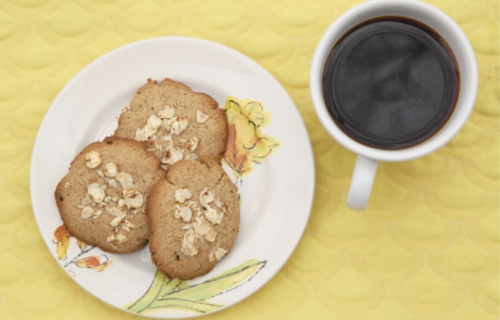
When you freeze the broth, how do you reheat it — and do you ever use the microwave.
Thanks!
Hi Pat,
Beth uses a microwave for some things, but not frequently. When she does use the mirco, she leaves the room while it is running. It depends on your own sensitivities as to what will be the best choice for you. You can reheat on the stovetop, too.
–Suz, Mast Cell 360
Brilliant! Thank you for inspiring another home broth narrative. I just couldn’t bear to give up my broth.
Does the meat need to be boneless or could you use a bone in chicken breast or a lamb chop? THANK YOU!!!
Hi Debbie,
You’ll want to use boneless.
Do you cook the meat in the broth or do you use precooked meat or is that a matter of preference?
Hi Will,
Either way works!
When you add 2 cups of meat – do you add the meat on the bone or just the meat itself. ie. do I add a whole chicken or just the breast/thigh?
Hi Cathy,
You’ll want 2 cups of boneless meat.
Why couldn’t I use frozen meat bones in my Instant Pot and cook for the shorter time? I use to do that before MCAS.
I get the butchered feet and backs (uncooked) from the chickens my farmer processes and freezes.
Is the meat added to the water raw or cooked? The picture looks like the chicken and onions were roasted first.
Hi Valerie,
Either way will work! Hope you enjoy!
I thought for sure we were not allowed to ‘thaw’ the meat at all! That is was crucial to immediatly cook it from a frozen state and then refreeze it quickly so bacteria would not grow. To roast in the oven would mean bacteria! And to thaw as she states in the recipe would mean bacteria! Please clarify for me as I’m so concerned about any bacteria at all growing!
Hi Christina,
Great question. Histamine levels do increase the longer the cook time. This recipe calls for a 20 minute simmer. But you are correct that roasting for several hours would increase histamine levels. So, generally speaking, shorter cook time = lower histamine. You should be fine at 20 minute cook time, but it really does depend on how sensitive someone is.
Thawing is necessary sometimes, but yes, cooking it from frozen in something like an instant pot is the most ideal. However, in instances where thawing is called for, you can thaw in the fridge until just frosty. Then cook as per directions. Just don’t thaw on the counter. That is the worst.
I hope this helps to clarify.
Best regards,
Suz, MC360
Hi, isn’t the point of bone broth to extract nutrients from the bone? If there’s no bone in this soup, can it still provide gut healing benefits?
Hi Jalissa,
You are correct that bone broth can be good for some people. However, for those with histamine intolerance, bone broth isn’t great. That’s because it is high histamine. Meat broth has the healing amino acids same as bone broth. And it supports the gut by being soothing to the digestive system. It’s also much lower in histamine and glycine (fewer oxalate/glutamate issues). So if you have MCAS/HIT, meat broth is the better option.
Suz
Thank you so much!
Is there any pre-made brand at all that can be recommended for those that are bed ridden or simply don’t have the energy to prepare this??
Hi Laura,
We haven’t tested any premade options ourselves, but maybe someone here in the community will be able to see your post and respond with anything they tried and worked. Generally, if you do look for pre-made options, frozen will probably be your best option (rather than canned) and just check out any ingredients against this foods list:
https://mastcell360.com/low-histamine-foods-list/
Suz
Would love to know if this will still be doable with ground meat? I buy flash frozen high quality bison and would love to get even more out of it! Thanks in advance! 😁
Hi Linn,
We haven’t tried it that way, but if you have luck with it, please let us know!
Linn.. where do you get your flash frozen Bison?!!!!
What do you do with the meat and vegetables you have strained out of the broth? Safe to eat 😅 f you have MCAS?
Hi Melissa,
If you start with a frozen meat (or thawed til frosty), you could eat the meat and veg from this safely if you eat it right away. Leftovers will increase in histamine levels, so be sure to freeze any cooked foods you can’t get to right away.
Mast Cell Activation Syndrome or Histamine Intolerance—What are it Symptoms ? or drinking bone broth – what symptoms indicate that one has histamine intolerance
Hi Nadeem,
Here are a couple articles you can check out:
The MCAS Symptoms Survey: https://mastcell360.com/do-you-have-more-than-just-histamine-intolerance-take-the-mast-cell-activation-syndrome-symptoms-survey/
Mast Cells and MCAS 101: https://mastcell360.com/mast-cells-and-mast-cell-activation-syndrome-101-what-to-know-if-you-have-mast-cell-activation-syndrome-or-histamine-intolerance/
What is Histamine Intolerance: https://mastcell360.com/what-is-histamine-intolerance-and-how-can-you-address-it-what-to-know-if-you-have-mast-cell-activation-syndrome-and-histamine-intolerance/
These articles should give you some good answers to your question.
Are there nutritional benefits to the broth over just eating the meat and veggies?
Hi Tara,
Sometimes people who are experiencing gut issues will eat broth or smoothies for a few days. It tends to be easier to digest, allowing the gut to rest. Generally, it is good to eat a variety of foods.
Suz, MC360
Is using collagen powder as a protein supplement contraindicated for histamine intolerance?
Hi Carol,
Beth doesn’t recommend collagen for her clients. Here’s where you can learn more about why: https://mastcell360.com/healthy-foods-to-avoid-when-you-have-mast-cell-activation-syndrome-or-histamine-intolerance/
Thanks for your interest in Mast Cell 360!
If I start with frozen meat, should I extend the cooking time? Is 20 minutes no histamine while 40 minutes would be low histamine?
Hi Liz,
Both 20 and 40 minutes are considered low histamine. You may need a little extra time if you start with frozen.
One more question. Is there any form of commercially available gelatin that is low histamine? Are some worse than others?
Hi Liz,
Gelatin is not usually recommended for those with MCAS or HIT. You can read more about that here: https://mastcell360.com/healthy-foods-to-avoid-when-you-have-mast-cell-activation-syndrome-or-histamine-intolerance/
I’d like to second Mom2one’s question. Can we use good-quality, quickly-frozen bones in the instant pot and cook for 20 minutes or so?
From what I’ve read on this website and others, it’s the cook time, not the bones, that is the problem. Is that correct?
Hi Lauren, with bones it isn’t so much that they need to be quickly frozen (although high quality pasture raised and frozen will be better in regards to histamine), it is the fact that when you make bone broth vs meat broth the bones will increase the collagen and gelatin in the stock. You can read more about why collagen and gelatin may be an issue for those with histamine intolerance and MCAS. Of course everyone’s level of sensitivity is different so you may feel free to experiment with it and various cook times and see how you feel.
Does meat broth have the same health benefits as bone broth when it comes to joint pain and inflammation in the body? I have knee issues and used to drink bone broth to help with the discomfort before I became sensitive to it. Thanks!
Hi Elaine, meat broth will still have some of the health benefits as bone broth as it will have some of the amino acids from the meat, but will be lower in the amino acid glycine. In regards to joint pain and inflammation, we recommend exploring with your medical practitioner the root cause of those issues to see if there are additional supports you can put in place, or if you can remove additional triggers such as oxalates, or lectins. Unfortunately, since we are unfamiliar with your individual case we cannot say for certain what might be causing your knee issues, but because of the high histamine levels, bone broth is not the best options for the joint pain and inflammation in your body and may actually be contributing to the issue if you are dealing with MCAS or histamine intolerance. If you haven’t read it yet, here is another post Beth has done on why some “healthy foods” aren’t a great option for MCAS: https://mastcell360.com/healthy-foods-to-avoid-when-you-have-mast-cell-activation-syndrome-or-histamine-intolerance/.
why boil the water first?? have always make broth by putting meat & veg into cold water, bring to a boil and then simmer.
Hi Grace. I believe you can do it either way. By boiling the water, you are reducing the “cook time” of the meat, which would essentially keep the histamines a little lower, but depending one your level of sensitivity this may or may not matter.
Should the meat have no skin? I heard skin was high in histamine but dont know if that affects the broth. Thanks!
Great question. The skin on cuts can be higher histamine. Cooking broth with it depends on how sensitive you are and how full your histamine bucket is. Since we aren’t familiar with your individual case this is something you could play around with when making your broth to see if it makes a difference for you, but the safest option for a lower histamine broth would be to remove the skin.
Can you reuse the meat for another batch of broth for later if cooked meat is refrozen?
Hi Eileen,
Good question. Re-using meat that’s already been cooked into broth to make more broth will do 2 things. 1) It will be a weaker broth because most of the flavor is already cooked out and 2) each subsequent broth will be higher histamine because of prior cooking, storing, etc. You could try it and see how you like it or do, but it will be higher histamine levels. We would suggest making a big batch of broth, freezing what you don’t need for future use and freezing the meat to be used in other recipes or eaten alongside the broth.
I hope that helps: https://mastcell360.com/are-you-raising-your-histamine-levels-with-these-meat-handling-mistakes/
Best,
Kam
Wondering if suitable to use this recipe for a ‘bone broth fast’? Just started Day1 of a 3-day fast, using a store bought bone-broth, and was reacting last night…. googled to find out that the bone broth was high histamine. Ooof.
So thinking to potentially continue the fast with your recipe instead- if safe/high enough in nutrients for fasting?? Thanks!!
Hi Daniel, This is a lower histamine alternative to bone broth, but since we are unfamiliar with your case we cannot say if this would be appropriate substitute for your fast and recommend discussing your concerns with your licensed medical provider.